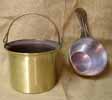
The patera at left is of the straight-sided type, lined with tin. The situla at right is also tin-lined.

MESS GEAR 1/26/13
The patera is an all-purpose mess pan, for cooking, eating, and probably drinking. It was made of bronze (brass may be used instead), and was apparently often spun from a blank which included the handle. Some examples do have handles added on in various ways, and some are hammered. The patera can be the "simple" style with a flat bottom and fairly straight sides, or have base rings cut in on the lathe, both to counterbalance the heavy handle and to distribute heat while cooking. Either type can be from 4" to 8" in diameter.
Images of an original ceramic
flask can be seen on the
Roman Hideout site:
http://www.romanhideout.com/images/LY/Cavarly_canteen_2-4_cent.b.asp
http://www.romanhideout.com/images/LY/Cavarly_canteen_2-4_cent.asp
Another good possiblity is that a leather flask was used to carry water, and carried in the net bag. Experiments with animal bladders have been less than successful, since they are delicate and tend to become brittle.
Simple cylindrical drinking cups are fairly common finds, perhaps 2-1/2" in diameter by 4" tall. Other types of cups based on original examples may also be used.
Spoons may be iron, bronze, wood, bone, or horn. A small knife is useful, and can have a folding blade. Folding knives were less common than regular ones, but here are some examples:
http://www.unas.org.uk/repros.html
http://penelope.uchicago.edu/Thayer/E/Gazetteer/Places/Europe/Great_Britain/_Periods/Roman/_Texts/WARREB/11*.html
Mark
Morrow makes a very good simple patera, plain brass or tin-lined.
Deepeeka's metal canteen/flask
is good, though it is best to line it with bees wax or brewer's pitch
and the stopper probably needs to be modified. Their newer patera
is acceptable, with a good bowl though the decoration on the handle is
raised instead of incised (their old patera is useless!). They
also have a reasonable bucket or situla.
Soul of the Warrior has the
Deepeeka Patera as well as their own version, with a better handle but
not quite such a nice bowl:
http://legvi.tripod.com/armamentarium/id325.html
FOOD
Roman marching rations included foods which could be preserved: hardtack (called bucellatum) or flour or unground wheat, bacon or salted meat, dried lentils, etc. Olive oil and garum (fish sauce) were also important, and "sour" wine called acetum was the common beverage. In garrison, there was fresh bread, meat, and vegetables, along with fruit and almost anything else that was edible.
A surviving recipe for hardtack/bucellatum is essentially the same as 18th century hardtack. I've made both, and keep some (several years old) in my satchel.
3 cups whole wheat flour
1 teaspoon salt
1 tablespoon olive oil
Mix it all up. Start adding water, a little at a time, to make a stiff dough. Form it into "pancakes" about 4" wide on ungreased cookie sheets, poke some holes in them, and put in oven at 250 degrees. After 2 hours, pry one off the pan and break in half--if it is hard and dry all the way through, it's done, but if not, give it another hour. Or simply turn the oven off and go to bed, they'll be done in the morning. Throw it all into a dirty linen bag and it will last forever (unless you are hungry enough to eat it!).
Note that giving samples of
food
to the public may be a violation of local health laws, so please
refrain
from doing so without authorization. It is usually effective
enough
to eat it yourself!
Garum! A Look at the Truth Behind this Foul Smelling
Fish Sauce
http://www.geocities.com/Athens/Ithaca/8337/c_garum.html